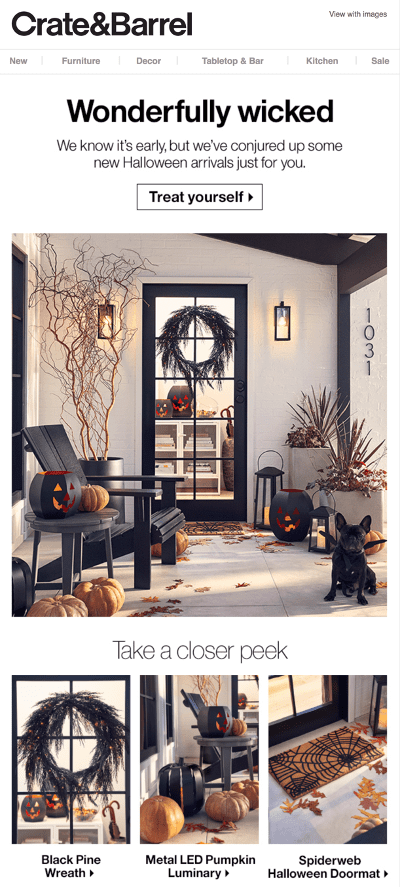Will Halloween 2020 be the equivalent of circus peanuts and peanut butter chews? Or will we find some full-size candy bars hiding in our treat sack?
Now that October is finally here, marketers are growing more confident that consumers will not sit out Halloween because of the COVID-19 pandemic—they’ll just celebrate it differently.
What’s Different With Halloween This Year?
In the U.K., large gatherings are out because of a ban on events with more than six people together, and trick-or-treating (or guising) is being actively discouraged.
In the U.S., some cities have banned door-to-door trick-or-treating, but others, like New York City, Chicago and Los Angeles, are allowing it with modifications. Parties will shrink to close friends and family, and the costume parade might happen on Zoom or Google Meet instead of the neighborhood sidewalk.
The National Retail Federation, which tracks key spending events like Halloween, predicts total U.S. spending on Halloween will dip to $8 billion, down from $8.8 billion in 2019. But the NRF also says per-person spending will go up as those who do plan to celebrate will spend more on decorations, candy and greeting cards.
5 Tips for Halloween Email Campaigns That Wow
Email marketers can still get plenty of mileage out of their Halloween marketing plans, even if the day isn’t the blockbuster it could have been pre-pandemic.
If you need some assistance and inspiration creating last-minute Halloween email campaigns, these five tips can help.
1. Use copy and images that reflect consumer desires to mix safety and fun
Halloween spending might be down, but there’s still $8 billion up for grabs, and possibly more if consumers decide to join in after all.
Still, with three-quarters of U.S. consumers telling the NRF that the COVID-19 pandemic has changed their Halloween plans, it’s a signal that email content should reflect this year’s revised reality in order to resonate with customers.
Try reviving the “we’re all in this together” theme that ran through many email campaigns earlier this year. It might have worn thin over the summer as the pandemic appeared to subside in many parts of the U.S. and around the world. But it will signal your concern for customer safety, especially because the virus is on the rise again in many parts of the U.S.
This campaign from HalloweenCostumes.com gets many things right with its timely focus on face masks as a part of the costume. It’s in keeping with CDC advice to keep wearing cloth coverings because Halloween masks don’t protect against the coronavirus.
The email also links to a section on safe trick-or-treating and promotes a virtual costume parade by inviting customers to post their pictures using the brand’s hashtag.


This HalloweenCostumes.com email combines safety, fun and a virtual costume parade on social media. Image via MailCharts.
2. Add some DIY editorial content to help customers feel like winners
Okay, so the big Halloween bash isn’t happening this year. But you can help your customers feel special about the plans they feel comfortable about keeping.
Offering tips on entertaining or creating a fun-but-safe costume for yourself or family members, or providing tutorials on makeup techniques, as in this PromGirl email, can help nudge customers toward a sale if your advice helps them solve a problem.


PromGirl’s makeup tutorial videos show customers how to create unique looks that could work even under a mask. Image via MailCharts.
Need a little content inspiration?
Check out the “Halloween Like We’ve Never Seen” campaign, sponsored by trade groups like the NRF, the Halloween & Costume Association, the National Costumers Association and the Paper First Affiliates and allied brands like Party City and Hershey.
It pairs a county-by-county map color-coded to show safe and risky areas and a list of acceptable activities for five levels of risk.
3. Help Halloween procrastinators join the party
Take a page from your holiday playbook, and let shoppers know when they need to order so they can get their merch on time. In the email below, Hot Topic posts its shipping cutoff date prominently, in Halloween-appropriate orange and black, so shoppers will be hard-pressed to avoid it.
And if you really want to target your last-minute shoppers, let them know about your Buy Online, Pick-up In Store (BOPIS) service if you offer it.


You can’t miss the shipping deadline, with day and time, in this Hot Topic email. Image via MailCharts.
4. Appeal to your bargain-hunters
Many consumers are hurting financially from furloughs and job losses as a result of the pandemic. Pull together a merchandise assortment that would appeal to people who love Halloween but need to do it on a budget this year.
The Party City email featured below is a virtual walk down the bargain aisle, with appealing merchandise at budget-friendly prices.
The clever copy delivers some fresh takes on the usual parade of clichés and terrible puns that pervade most Halloween copy, like “Torment the neighbors with these Halloween decoration ideas.” (Time to put a stake through the heart of “spooktacular!”)


Party City’s email campaign feels a little like trick-or-treating for bargains. Image via MailCharts.
5. Tip for 2021: Start early!
Is August too soon to start promoting Halloween? Not for décor stores like Grandin Road and Crate and Barrel, which go to the dark side at the peak of summer.
Crate and Barrel’s email, sent in early August, wins on several fronts. The sly copy (“We know it’s early, but …”) makes the email feel like a VIP sneak peek. The subject line stands out: “Brewing up some new Halloween arrivals.” And the images, which style the merchandise in aspirational home settings, are more appealing than straight catalog pictures.


Is August too early to introduce new Halloween décor? True fans will say “Bring it on!” Image via MailCharts.
What’s the best time to send Halloween email campaigns? In 2020, anything goes.
In past years, brands began promoting Halloween slowly, often mixing in content in the bottom half of the message before moving it to the featured position in early to mid-September, after back-to-school promotions subsided but before holiday/Christmas marketing began in earnest.
The surge usually began to build about the third week of September, as brand emails mentioning Halloween increased and themes shifted from “what’s new for Halloween” to promotion-led campaigns. The peak for Halloween frequency and promotion would come in the three to four days before the event and continue for two or three days afterwards as brands promote post-Halloween sales to clear out inventory.
The coronavirus pandemic of 2020 has thrown the usual Halloween promotion cycle off track. Many brands, even Halloween stalwarts like Party City, have held back on frequency, promotion rate and promotion value because of uncertainty over regulations on large gatherings and trick-or-treating and consumer interest. Others, like HalloweenCostumes.com, are sending more frequently and increasing both the value and number of promotions.
Also in 2020, Amazon’s delayed Prime Day event and promotions from competitors like Target and Walmart could divert even more attention and consumer spending away from Halloween. Retailers should work harder than usual to create attention-getting headlines that grab attention in the inbox and stand out from the Prime Day hoopla.
Wrapping Up: A Few Words About Subject Lines
Take the time to make them great. That’s how you’ll get your Halloween email campaigns noticed in the inbox.
These three caught our eye as we browsed emails:
- “Sinister merch for humans & ghosts with the most” (Hot Topic)
- “Give ‘em pumpkin to talk about. Is your ride trunk-or-treat ready?” (Party City)
- “Trick or treat, short and sweet” (Tipsy Elves)
Work on your originality, too. You know all those great puns you love? So do a lot of other marketers. Spend some time scrolling through Halloween email collections on sites like Really Good Emails and MailCharts, and look at the subject lines that catch your eye.
(We said earlier that we’re so over “spooktacular” because it’s a cliché. But it has a bigger problem: It has a racist history because “spook,” derived from a Dutch word meaning “specter,” evolved into a slur used against Black people. Trade it in for something else, like “fangtastic.”)
Halloween might not be a major holiday for your brand, but a little carefully chosen imagery and copy can spruce up any email and give you a hook for extra attention.
Want to learn more e-commerce trends during the 2020 holiday season? Check out these top consumer insights from Iterable’s holiday shopping survey.































